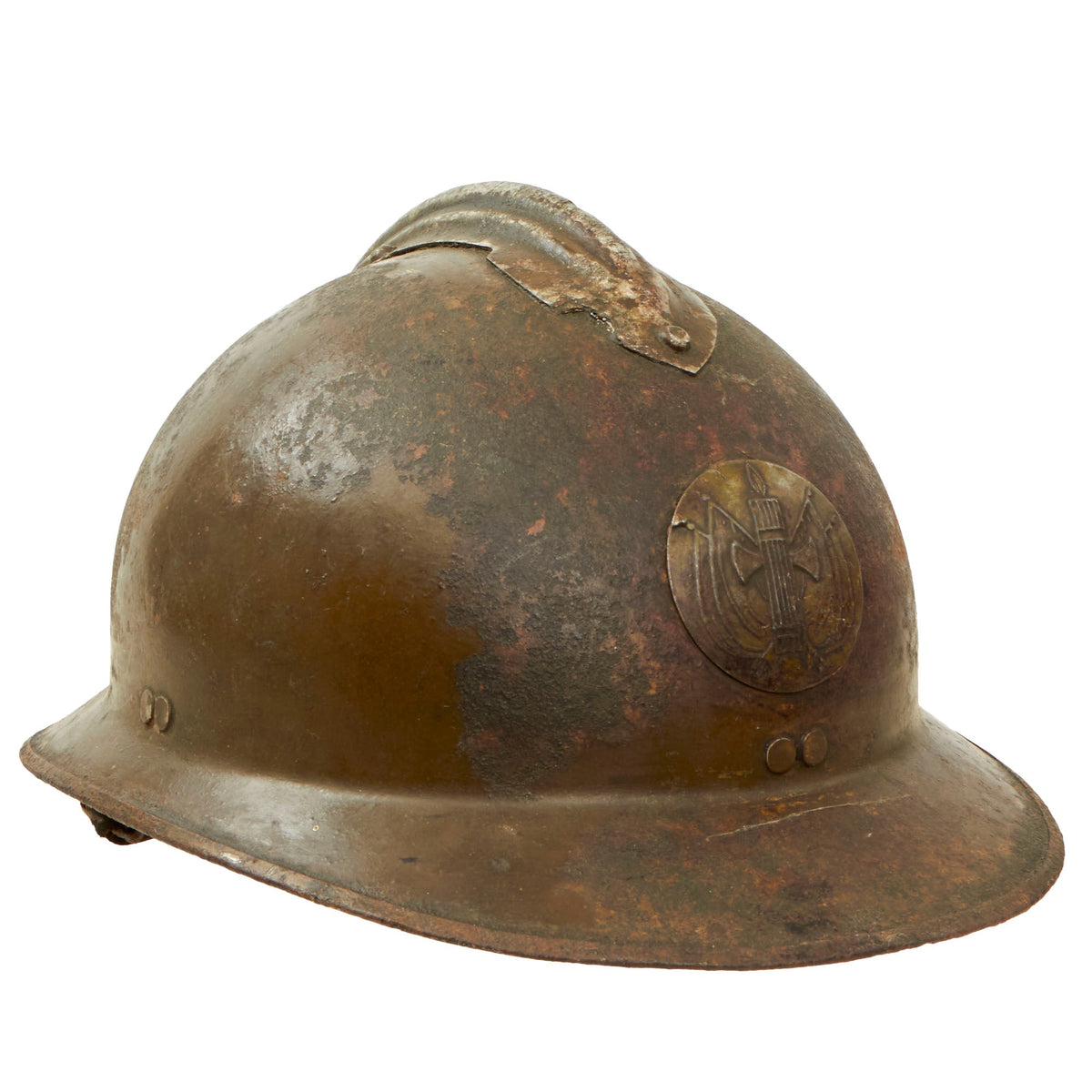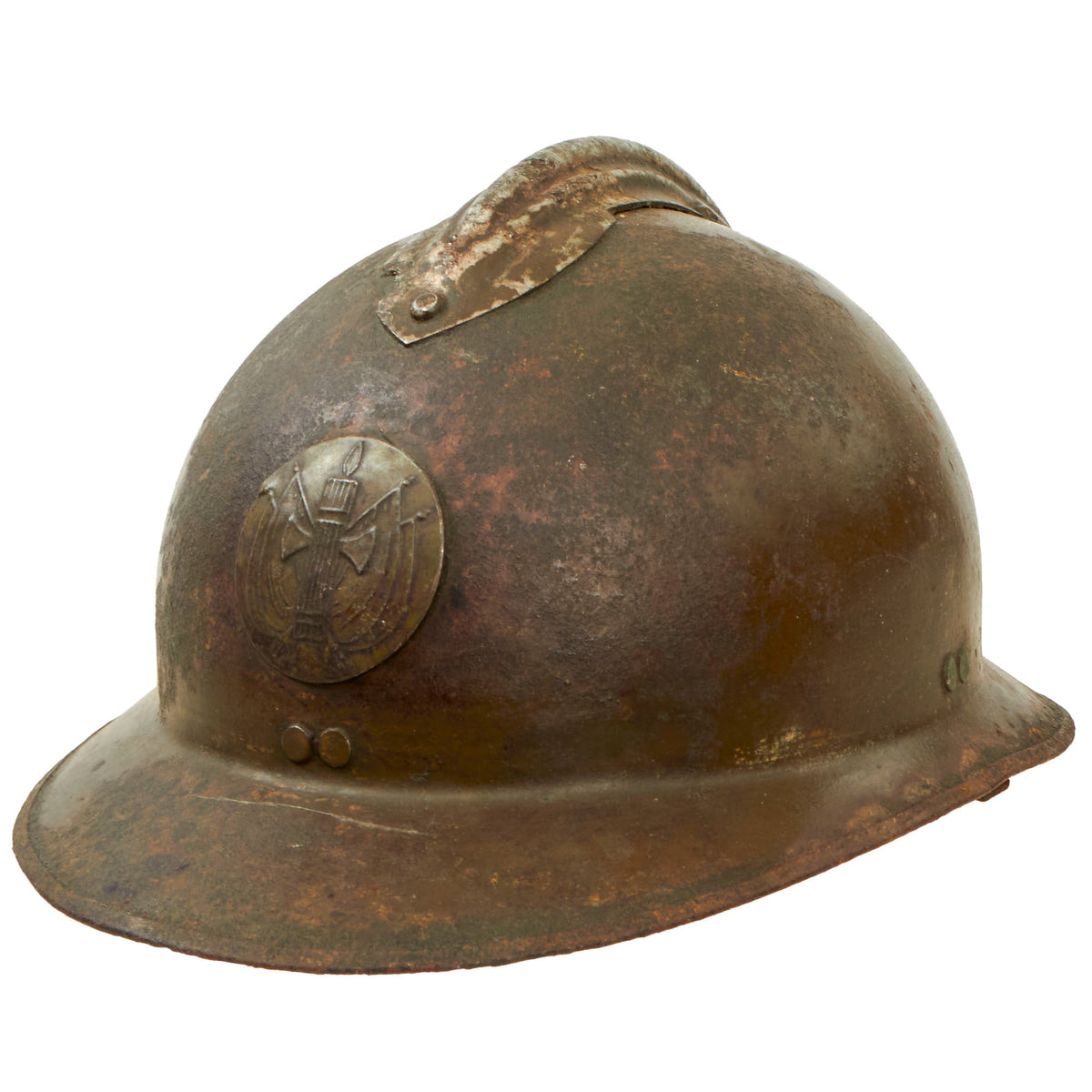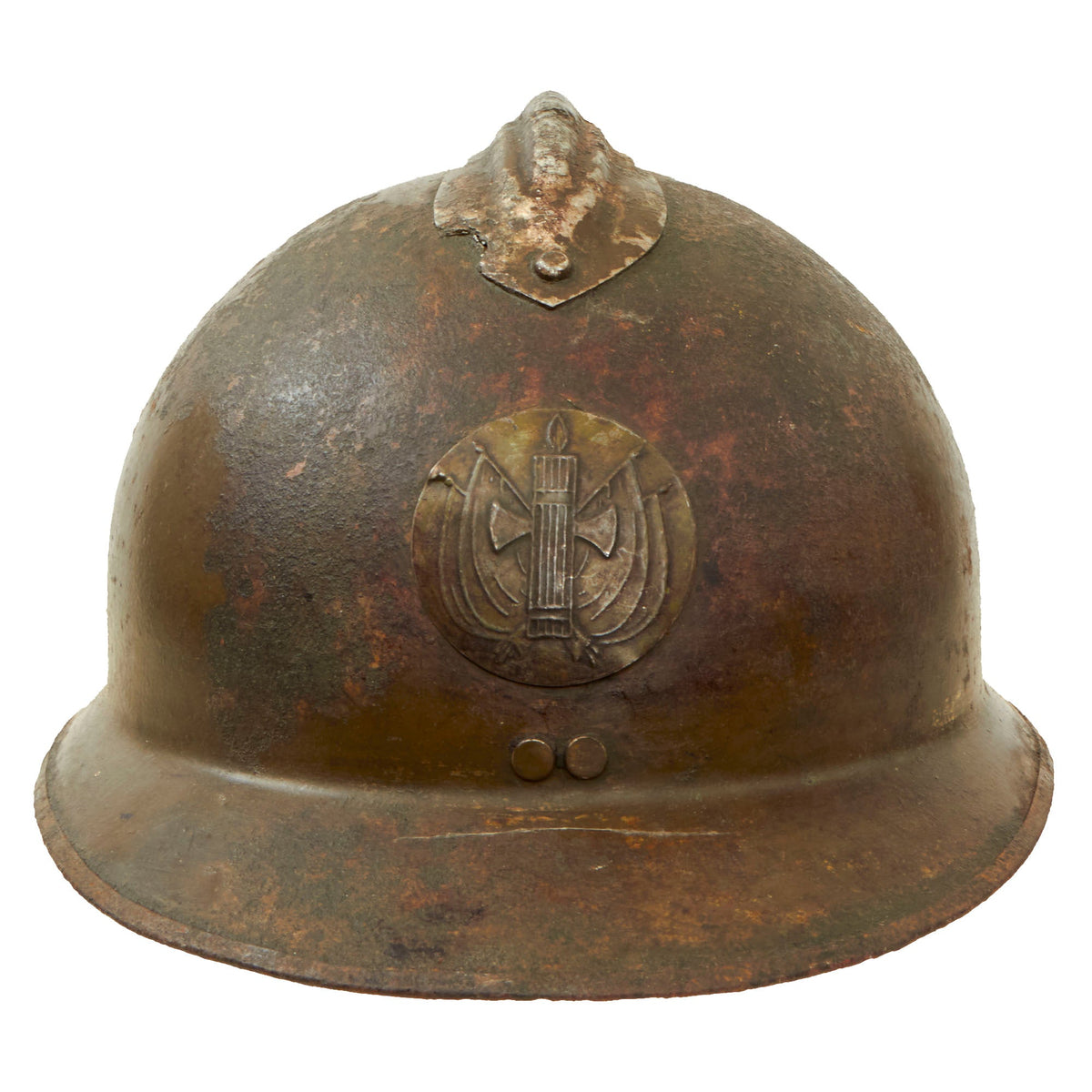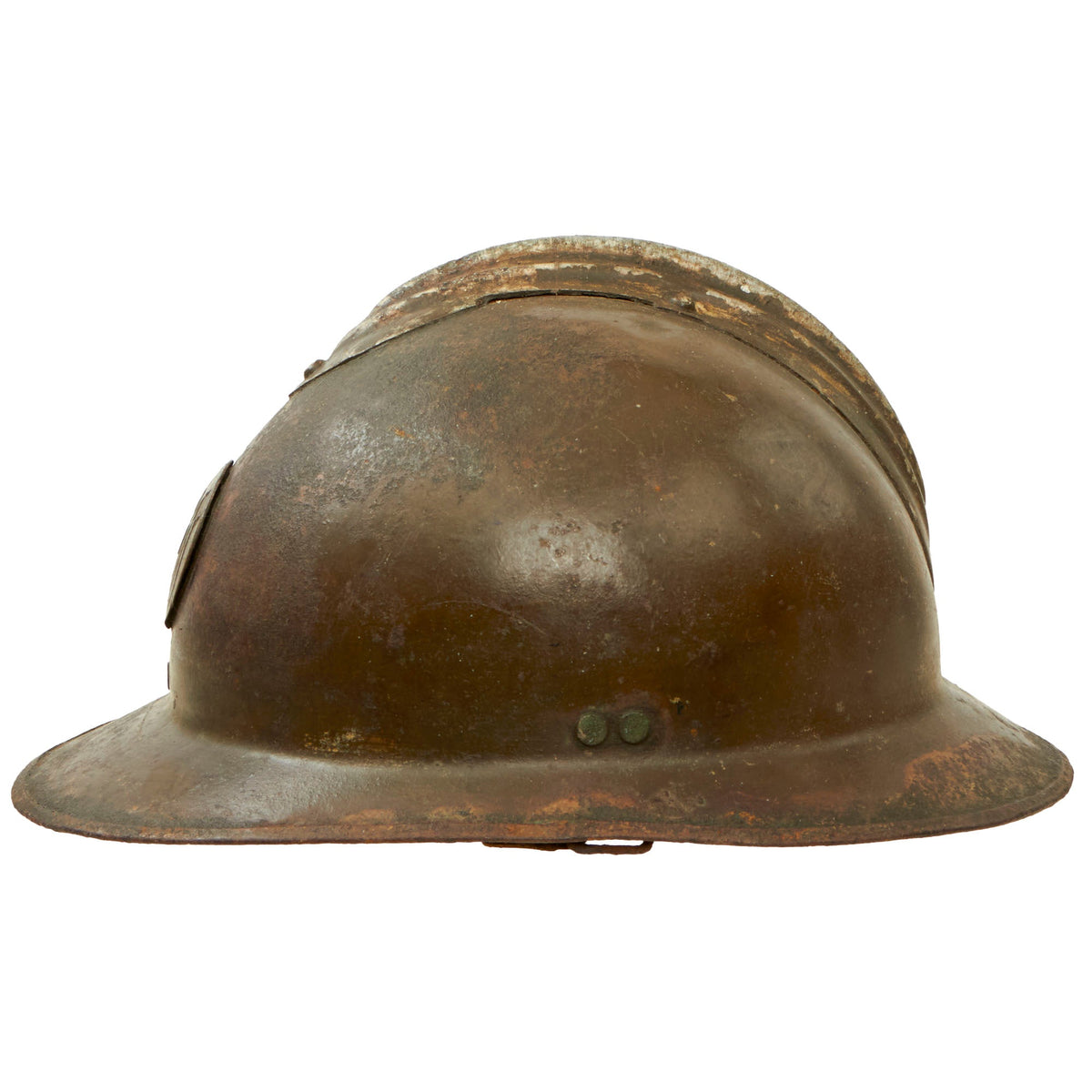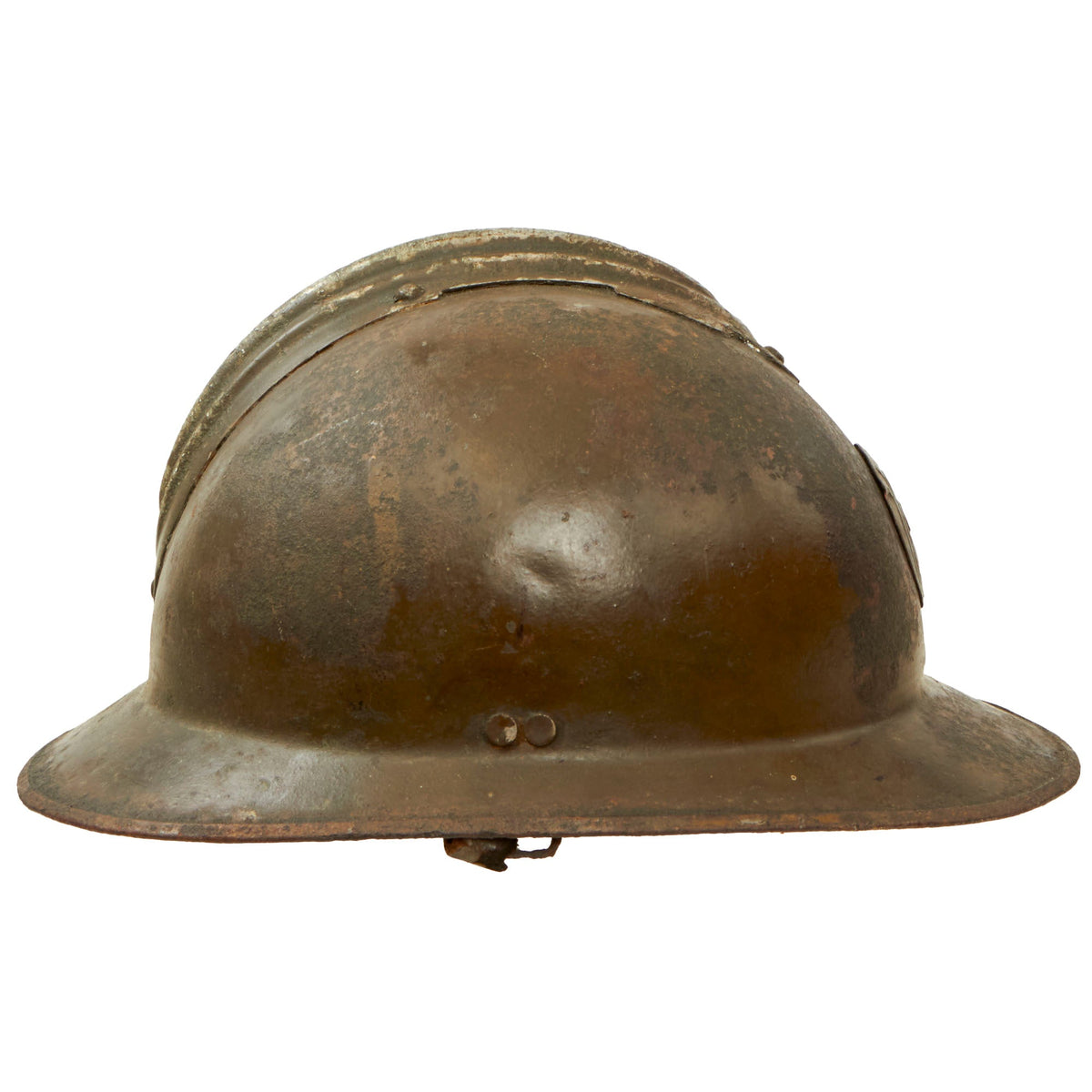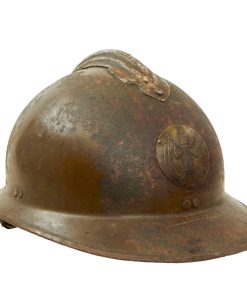Original French WWII M-1926 Adrian Helmet with Rare Vichy Badge Original Items
$ 595,00 $ 178,50
Original Item: Only One Available. This is a very rare bird that doesn’t come up often. A genuine very good condition M1926 French “Adrian” helmet. It is still painted in the original Olive Green, but sports a badge for the Pro-Fascist Government in Vichy. After the Fall of France on June 25, 1940, France was divided into occupied territory in the North, and the south was put under the administration of the Pro-Germany Fascist government based in Vichy, France.
The helmet is in rough condition overall with about 50% of its original olive green paint remaining, There is a very rare badge for the government of Vichy which features the fascist fasces insignia, a bundle of wooden rods and an axe bound together by leather thongs. Fasces represented that a man held imperium, or executive authority. The fasces is in front of several flags, representing Fascist ideology reigning supreme over all others.
The helmet does not retain its liner but does retain its original leather chinstrap which is itself in rough shape, but still complete. The shadow around the badge does signify that it has always been with the helmet, making this a very rare example of a scarce helmet. Ready for further research and display.
Vichy France (French: Régime de Vichy)
This is the common name of the French State (État français) headed by Marshal Philippe Pétain during World War II. Evacuated from Paris to Vichy in the unoccupied “Free Zone” (zone libre) in the southern part of metropolitan France which included French Algeria, it remained responsible for the civil administration of France as well as the French colonial empire.
From 1940 to 1942, while the Vichy regime was the nominal government of all of France except for Alsace-Lorraine, the Germans and Italians militarily occupied northern and south-eastern France. While Paris remained the de jure capital of France, the government chose to relocate to the town of Vichy, 360 km (220 mi) to the south in the zone libre, which thus became the de facto capital of the French State. Following the Allied landings in French North Africa in November 1942, southern France was also militarily occupied by Germany and Italy to protect the Mediterranean coastline. Petain’s government remained in Vichy as the nominal government of France, albeit one that collaborated with NSDAP Germany from November 1942 onwards. The government at Vichy remained there until late 1944, when it lost its de facto authority due to the Allied invasion of France and the government was compelled to relocate to the Sigmaringen enclave in Germany, where it continued to exist on paper until the end of hostilities in Europe.
The 1926 Adrian Helmet
In 1926 the Adrian helmet was modified by being constructed of stronger steel and simplified by having the main part of the helmet stamped from one piece of metal, and therefore without the joining rim around the helmet that characterizes the M15. The large ventilation hole under the comb, which had been a weak point of the old design, was also replaced with a series of small holes. The M26 helmet continued in use with the French Army until after World War II, and was also used by the French police up to the 1970s. During the interwar period Belgium began to produce their own domestically made M26 Adrians and exported them around the globe. These helmets can be distinguished from their French counterparts, because they have a slightly different comb and a wider rim. In other countries the Adrian-type helmets were also in use with the fire-fighting units, railway guards or marine infantry (e.g. Japan’s SNLF). Adrian helmets are still prized by collectors today.
The M15 Adrian helmet (French: Casque Adrian) was a combat helmet issued to the French Army during World War I. It was the first standard helmet of the French Army and was designed when millions of French troops were engaged in trench warfare, and head wounds from the falling shrapnel generated by the new technique of indirect fire became a frequent cause of battlefield casualties. Introduced in 1915, it was the first modern steel helmet and it served as the basic helmet of many armies well into the 1930s. Initially issued to infantry soldiers, in modified form they were also issued to cavalry and tank crews. A subsequent version, the M26, was used during World War II.
Fast Shipping with Professional Packaging
Thanks to our longstanding association with UPS FedEx DHL, and other major international carriers, we are able to provide a range of shipping options. Our warehouse staff is expertly trained and will wrap your products according to our exact and precise specifications. Prior to shipping, your goods will be thoroughly examined and securely secured. We ship to thousands clients each day across multiple countries. This shows how we're dedicated to be the largest retailer on the internet. Warehouses and distribution centres can be located throughout Europe as well as the USA.
Note: Orders with more than one item will be assigned a processing date depending on the item.
Before shipping before shipping, we'll conduct a thorough inspection of the items you have ordered. Today, the majority of orders will be delivered within 48 hours. The delivery time will be between 3-7 days.
Returns
The stock is dynamic and we cannot completely manage it because multiple stakeholders are involved, including our factory and warehouse. So the actual stock may alter at any time. It's possible that you may not receive your order once the order has been made.
Our policy is valid for a period of 30 days. If you don't receive the product within 30 days, we are not able to issue a refund or an exchange.
You can only return an item if it is unused and in the same state as the day you received it. You must have the item in its original packaging.
Related products
Uncategorized
Uncategorized
Uncategorized
Uncategorized
Uncategorized
Armoured Fighting Vehicles of the World: AFVs of World War One (Hardcover Book) New Made Items
Uncategorized
Uncategorized
Uncategorized
Uncategorized
Uncategorized
Uncategorized
Uncategorized
Australian WWII Owen MK1 Machine Carbine SMG Custom Fabricated Replica with Sling Original Items
Uncategorized
Uncategorized
Armored Burgonet Helmet & Polearm from Scottish Castle Leith Hall Circa 1700 Original Items
Uncategorized
Uncategorized
Uncategorized
Uncategorized
Band of Brothers ORIGINAL GERMAN WWII Le. F.H. 18 10.5cm ARTILLERY PIECE Original Items
Uncategorized
Uncategorized
Uncategorized
Uncategorized
Angolan Rebel 1970s era 60mm Inert Display Mortar from Angolan Civil War Original Items
